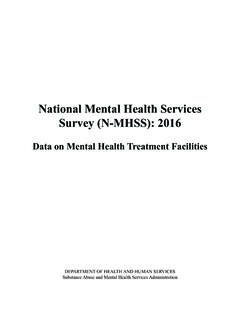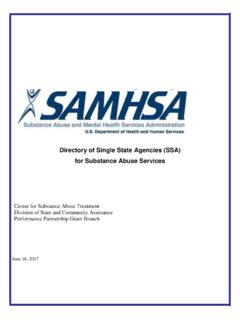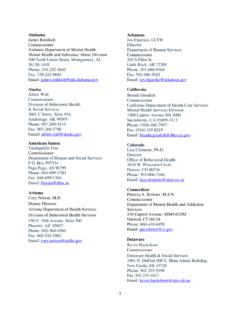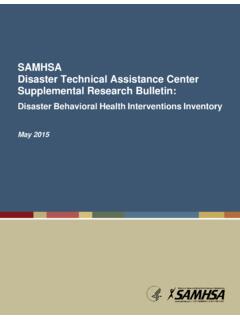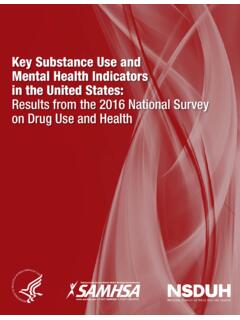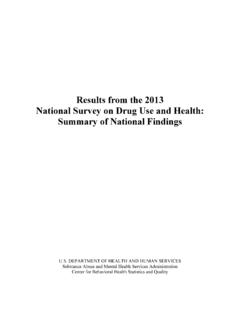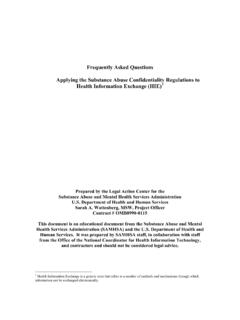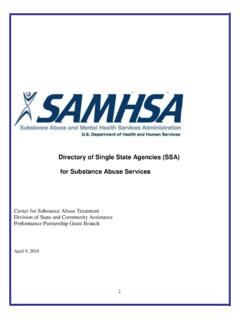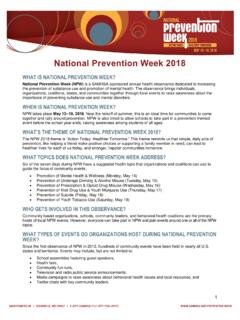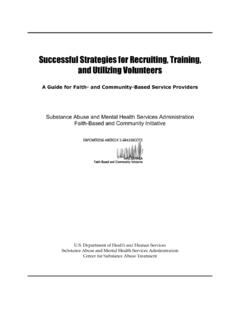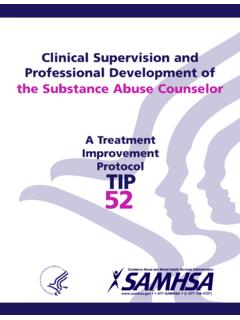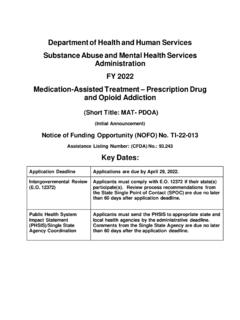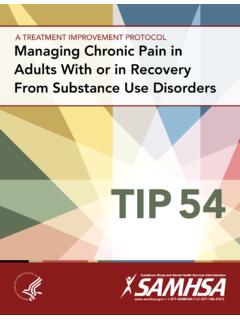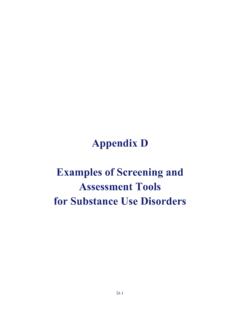Transcription of 2018 National Survey on Drug Use and Health: African …
1 12018 National Survey on Drug Use and Health: African AmericansSubstance Abuse and Mental Health Services Administration Department of Health and Human Services2 National Survey on Drug Use and Health (NSDUH) NSDUH is a comprehensive household interview Survey of substance use, substance use disorders, mental health, and the receipt of treatment services for these disorders in the United States. NSDUH is collected face-to-face by field interviewers who read less sensitive questions to respondents and transition respondents to audio computer assisted self-interviewing for sensitive items. NSDUH covers the civilian, noninstitutionalized population, aged 12 or older: Includes: Households, college dorms, homeless in shelters, civilians on military bases Excludes: Active military, long-term hospital residents, prison populations, homeless not in shelters Sample includes all 50 states and DC Approximately 67,500 persons are interviewed annually Data collected from January to December 3 How Do We Use NSDUH?
2 Provides a window into the state of substance use and mental health issues in the United States Helps to guide policy directions: problem substances prevalence of mental illness intersection of substance use and mental health issues provides insights that can be studied in the context of data from other agencies to help in decision-making about what types of resources are needed and where resources should be directed4 NSDUH 2017 Highlights Opioids epidemic: New users of heroin significantly decreased relative to 2016 Significant decreases in pain reliever misuse were observed for all ages Downward trend in heroin users Estimated with opioid use disorder Marijuana: Significant increases in use by young adults (18-25 ): past month and daily/near daily use; with significant increases in use by young adult women Pregnant women using substances in greater numbers including significant increases in daily or near daily marijuana use Frequent marijuana use was associated with opioid misuse, heavy alcohol use, and depression in youth 12-17 and young adults 18-25 Young adults had increasing rates of serious mental illness, major depression, and suicidality Co-occurring substance use and mental disorders are common Major gaps in treatment received by affected individuals5 SAMHSA s Response to 2016-17 NSDUH Findings 2018.
3 Launch of new approach to technical assistance and training Previous focus on technical assistance to grantees expanded to National approach Establishment of Clinical Support System for Serious Mental Illness National practitioner training efforts Focus on appropriate use and monitoring of psychotropic medications Use of clozapine in treatment refractory schizophrenia Assisted outpatient treatment Establishment of a regional system of Technology Transfer Centers throughout the Substance Abuse Prevention Technology Transfer Centers Addiction Technology Transfer Centers Mental Health Technology Transfer Centers with supplements for school-based services Training and technical assistance tailored to needs of HHS regions Native American/Alaska Native, Hispanic/Latino focus centers Establishment of new National training/technical assistance programs State Targeted Response/State opioid Response TA/T Program-over 1000 requests met Privacy Technology Transfer Center addressing confidentiality and information sharing related to HIPAA and 42 CFR Eating Disorders Technology Transfer Center 6 SAMHSA s Response to NSDUH Findings Established PCSS-Universities to embed DATA waiver training in pre-graduate education for physicians, nurse practitioners and physician assistants Expanded training and technical assistance on opioids issues in rural America through supplements to USDA Cooperative Extension programs Re-established the Drug Abuse Warning Network (DAWN) Expanded the Suicide Prevention Lifeline network Public targeted messaging based on areas of concern identified in NSDUH.
4 Marijuana, methamphetamine, suicide prevention7 Mental Illness and Substance Use Disorders among African American Adults (>18 )8 Alcohol Initiates among African AmericansOverall US population Use among African AmericansOverall US population US population US population 26+ Use Disorder among African AmericansOverall US population US population : Alcohol Use in 2018 No significant change in alcohol use initiation rate among African American youths since 2015 Declines in alcohol use disorder among African American youth and young adults during 2015-2018 SAMHSA efforts on reductions in alcohol use in children/youth/transition age youth: CSAP DFC program prioritizes alcohol use and has reported a 27% reduction in use in middle-school and a 23% reduction in use by high school students SAMHSA Prevention Technology Transfer Centers produce resources and materials related to alcohol misuse prevention CSAP Talk They Hear You focuses on underage drinking CSAP requires Partnerships for Success grantees to emphasize underage drinking prevention CSAT has promoted SBIRT for alcohol use in all programs including CJ, PPW, adolescent treatment , HIV and homeless programs CSAT has funded SBIRT training in medical residencies and other healthcare practitioner programs which screen for hazardous alcohol use and use disorders12 Illicit Drug Use among African Americans.
5 Marijuana Most Used DrugOverall US population 12+ US population 12+ Pain Reliever Misuse among African Americans 14 opioid Misuse among African Americans 15 Prescription Pain Reliever Misuse and Heroin Use among African Americans16 Prescription Pain Reliever Misuse among African Americans17 Sources Where Pain Relievers Were Obtained for Most Recent Misuse among African Americans Who Misused Prescription Pain Relievers18 Misuse of Prescription opioid Subtypes among African AmericansOverall US population 12+ US population 12+ US population 12+ Use among African Americans20 Heroin Use among African Americans21 Heroin-Related opioid Use Disorder among African Americans22 treatment Gains: Number of Individuals Receiving Pharmacotherapy for opioid Use Disorder (MAT)345,443520,39846,860382,867581,6136 4,020450,247648,86473,260010000020000030 0000400000500000600000700000 MethadoneBuprenorphineNaltrexone20162017 2018 Note: Estimates do not represent African Americans and are not based on ,6921,028,5001,172,371020000040000060000 0800000100000012000001400000201620172018 Total Number receiving MAT (all types)23 Summary.
6 opioid Misuse and Use Disorder in the United States in 2018 Among African Americans aged 12+, significant decreases in prescription opioid misuse initiation, misuse, and use disorders during 2015-2018 Majority of African Americans continue to obtain from friends/relatives and from healthcare provider/prescriber underscoring the need for ongoing education of practitioners, appropriate pain management, and partnership with states to monitor opioid prescribing Significant decreases in prescription opioid misuse among African American youth and young adults No significant changes in heroin initiation, heroin use, and heroin use disorder among African Americans during 2015-201824 Other Illicit Substances25 Marijuana Use among African AmericansOverall US population 26+ US population Use among African American Young Adults (18-25 )Overall US population Use among African American Young Adult Men and Women (18-25 )Overall US population Male US population Increase in Marijuana Use among African American Adults 26+Overall US population 26+ Use Disorder among African Americans30 Past Month Substance Use among African American Pregnant WomenOverall Pregnant Women 15-44 Pregnant Women 15-44 Use among African American Women by Pregnancy StatusOverall Women 15-44 or Almost Daily Marijuana Use among African American Women by Pregnancy Status332017: Showed a startling increase in substance use and particularly marijuana use in pregnancy: may be associated with fetal growth restriction, stillbirth, and preterm birth.
7 May cause problems with neurological development, resulting in hyperactivity, poor cognitive function(Metz TD and StickrathEH, 2015)Substance Use in Pregnancy: Trends in the Right Direction No significant changes in these measures between 2017 and 2018 SAMHSA/HHS made strong efforts to address this situation in an effort to improve the health and mothers and their babies: Public awareness efforts: information sharing with stakeholders and the public Launch of Launch of Substance Abuse Prevention Technology Transfer Centers with a focus on marijuana and other substance use in pregnancy Expansion of treatment programs for pregnant/post partum parenting women: both residential and outpatient through CARA Publication of Clinical Guidance for Treating Pregnant and Parenting Women with opioid Use Disorder Publication of Healthy Pregnancy/Healthy Baby Factsheets for women and their families Use of STR and SOR funding for opioid use disorder in pregnancy and prevention interventions Joint article from Assistant Secretary for Mental Health and Substance Use and Surgeon Generaladdressing treatment of opioid use disorder in pregnancy34 Cocaine Use among African Americans35 Methamphetamine Use among African Americans36 Methamphetamine Use among African Americans by State37 Misuse of Prescription Stimulants among African AmericansOverall US population American Hallucinogen Use: LSD Overall US population.
8 Other Substance Use in the United States in 2018 Significant increase in marijuana use among African Americans aged 26+ in 2015-2018 No significant changes in marijuana use disorder among African Americans across all age groups No significant change in illicit drug use by African American pregnant women, including marijuana use No significant changes in cocaine use, methamphetamine use, LSD use, and prescription stimulant misuse among African Americans across all age groups PREVENTION WORKS!40 Mental Health41 Serious Mental Illness (SMI) rising among African American Young Adults (18-25 ) 42 Major Depressive Episodes among African AmericansOverall US population US population US population Depressive Episodes with Severe Impairment among African American AdolescentsOverall US population Depressive Episodes with Severe Impairment among African American Young Adults (18-25 )Overall US population Female US population Male Thoughts, Plans, and Attempts among African American Young Adults (18-25 )Overall US population Disorders47Co-Occurring Issues: Substance Use Is More Frequent among African American Adults (>18 ) with Mental IllnessOverall US population 18+ US population 18+ US population 18+ US population 18+ Issues.
9 Substance Use Is More Frequent among African American Adults (>18 ) with Mental IllnessOverall US population 18+ US population 18+ US population 18+ US population 18+ US population 18+ Use Related to Other Substance Use, MDE and SMI among African Americans50 Marijuana Use Related to Other Substance Use, MDE and SMI among African Americans51 opioid Misuse Related to Other Substance Use, MDE and SMI among African Americans52 Cocaine Use Related to Other Substance Use, MDE and SMI among African Americans53 Methamphetamine Use Related to Other Substance Use, MDE and SMI among African Americans54Co-Occurring Substance Use Disorder (SUD) is Associated with Suicidal Thoughts, Plans, and Attempts among African American AdultsOverall US population 18+ US population 18+ Consequences and Disease Burden, treatment Gaps among African Americans Remain VastOverall US population 18+ US population 18+ US population : Mental Health and Substance Use Issues in the United States in 2018 Significant increases in serious mental illness among African American young adults aged 18-25 during 2015-2018 and among African American adults aged 50+ during 2008-2018 Significant increase in major depressive episode among African American young adults Significant increase in major depressive episode with severe impairment among female African American young adults Significant increase in serious thoughts of suicide in African Americans aged 18-25 Co-occurring substance use is more frequent among African Americans with mental illness Among African Americans, use of one substance alcohol or other illicit substances--is strongly correlated with polysubstance use and with major depressive episode and serious mental illness underscoring the need to screen for all substances as well as mental disorders when evaluating a person identifying a substance problem or a mental health issue.
10 And to treat all co-occurring disorders Substance use disorders are associated with increased risk for suicidality among African Americans The large gap in treatment need continues among African Americans572018: A Year of Some Progress, but Ongoing Need for Americans Living with Substance Use and Mental Health Issues ContinuesNSDUH reveals areas where we need to focus resources for African Americans: Continuing need to address the ongoing opioid epidemic Significant increase in marijuana use among African American adults aged 26+ Significant increase in major depressive episode among African American young adults aged 18-25 Substance use and mental disorders among African American are closely linked: NSDUH tells us that illicit substance use is associated with increased risk for other hazardous substance use and mental illness, and mental illness is a risk factor for illicit substance use among African Americans Need for ongoing efforts in prevention of substance use disorders among African Americans58 SAMHSA s Response Workforce: Continue to address the need for clinicians to be prepared to assess and treat mental health issues and substance issues with National training and technical assistance programs Opioids Continue work with states to address opioids crisis needs in terms of prevention, treatment , and community recovery resources STR/SOR/TOR grants Discretionary grants: pregnant/post partum parenting women/children/families, drug courts, first responder/prevention grants Collaboration with HHS partners and other federal departments to expand resources to communities Other substances.
